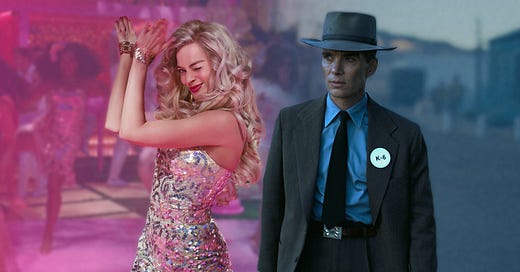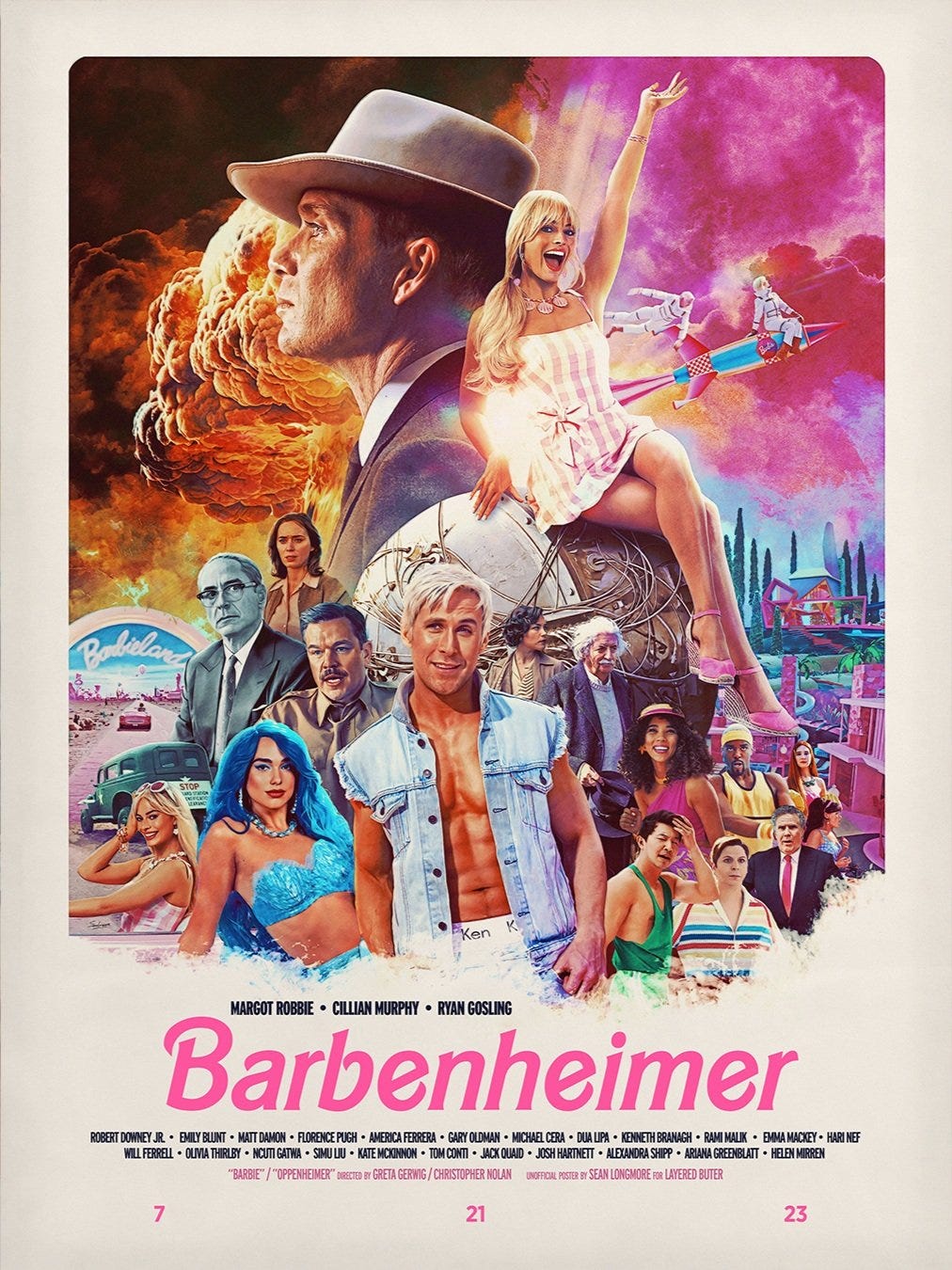Barbenheimer & The Atomic Blonde Aftermath — Cultural Digest #12
Did the double bill of the century live up to the hype? Why these two movies could help save the ailing film industry.
*Do call me out if I’m wrong but I’m going to say no spoilers ahead, a few descriptive elements but nothing that would take away from your enjoyment of either movie.*
GET ME TO THE CINEMA.
The big studio movie has been having a thrilling and long overdue resurgence. Top Gun: Maverick. Dune. Indiana Jones. And as you will know unless you’ve been living under a rock (I don’t blame you, my preference is definitely for more of a Fraggle Rock-based lifestyle) now not one, but TWO juggernauts hit our screens at once — on the same opening weekend. And one of them was a comedy directed by a woman. Lol.
Contrary to the usual head to head box office battle which causes untold amounts of misery, postponements and marketing nightmares in production offices everywhere (and despite the deeply irritating insistence of click-bait journalists desperate to snag a contentious headline and create a false rivalry) — Barbie and Oppenheimer capitalised on their joint release and I was 100% here for it.
Cillian Murphy, Oppenheimer of Oppenheimer, when asked what he thought about it responded: “It’s all love. How fantastic to have two movies by two fantastic directors coming out at the same time. You get to spend all day in the cinema. What could be better?”, whilst Margot Robbie and Greta Gerwig posed in front of a giant Oppenheimer poster grinning and clutching their tickets.
Some might suggest that these were cleverly constructed PR stunts but I know they were genuine because I would be exactly the same and not just because I’m a cheeky chappy and I love films but because of the dangerous precipice my industry finds itself upon at this moment in time. You would be mad not to be encouraging everyone to go and see everything. I think most industry professionals will be thanking the heavens that there’s some excitement about going to the cinema again. For all the diatribe and analysis that has surrounded these releases regardless of how good they are or not, I believe they serve as an essential contribution to the survival of the film industry which despite Hollywood’s ever-glistening outward sheen, is in dire financial trouble.
Oppenheimer tells the story of J Robert Oppenheimer, the creator of the atomic bomb. Its director, Christopher Nolan, has hailed the movie as a siren call to us all with the encroaching advancements of AI. But what really drew me in and convinced me to see this movie, other than the media storm furore? Its poster.
WHAT. A. STUNNER.
Take another look. Seriously, if it’s not coming up properly on your device, have a quick search for an image that does. It’s a heart-stopper.
I feel like I haven’t seen a movie poster like this in years. An image that grabs you by the lapels, that captures the essence of a story in one gut-punch, that assaults the senses, that illuminates your imagination with a bazillion multicoloured feelings, that in and of itself is saying something about humanity and about cinema — that inspires, intrigues and compels you to go and see it. I saw this poster months ago and from that moment, Oppenheimer was bookmarked in my calendar.
More recently posters like these have been sidelined in favour of star ratings and glowing critics quotes surrounding a towering mountain of heavily air-bushed actors, each seemingly growing out of the other, status determined by size, and occasionally peppered with a desperate tag of “brought to you by the makers of X, Y and Z” — this could literally mean one person that was involved in something that hundreds of other people were fundamental in the success of years before, by the by. They are the laziest of marketing tactics that mirror the disturbing commercialisation of the film industry and it’s disconnection from its storytelling roots. It’s a grasping at straws approach to an industry that has become plagued by profiteering. The posters are intentionally generic and neutral — note too the obsession with orange and blue colour palettes that are utilised on nearly every poster in the world of franchise. Studios have come to rely on people showing up to the cinema because of their investment in them as a brand, more than the story or characters themselves.
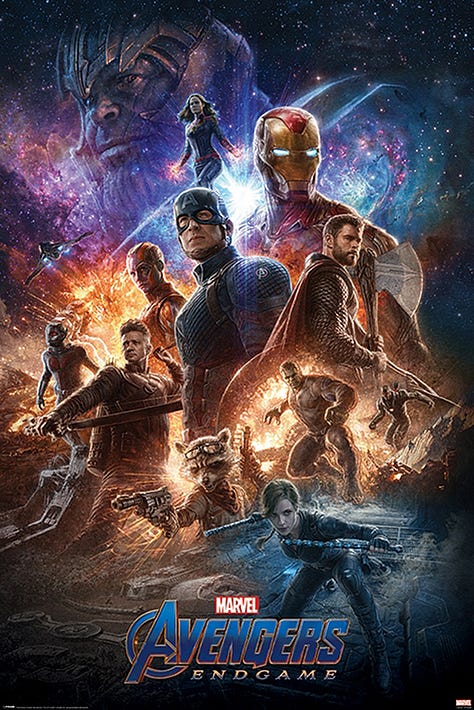
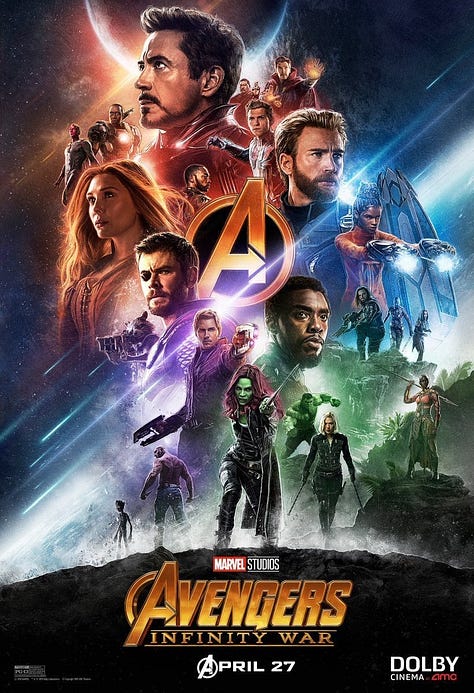
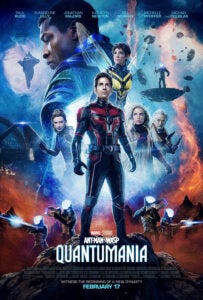
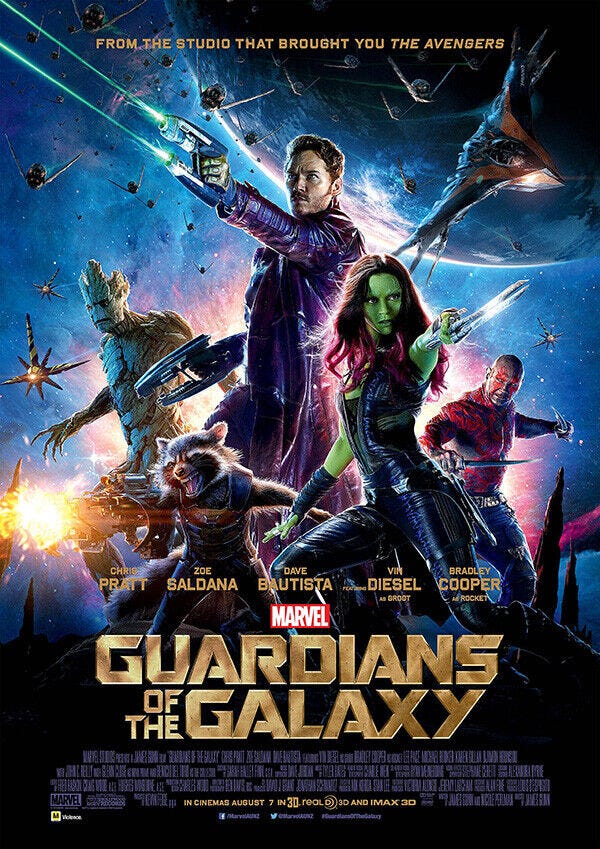
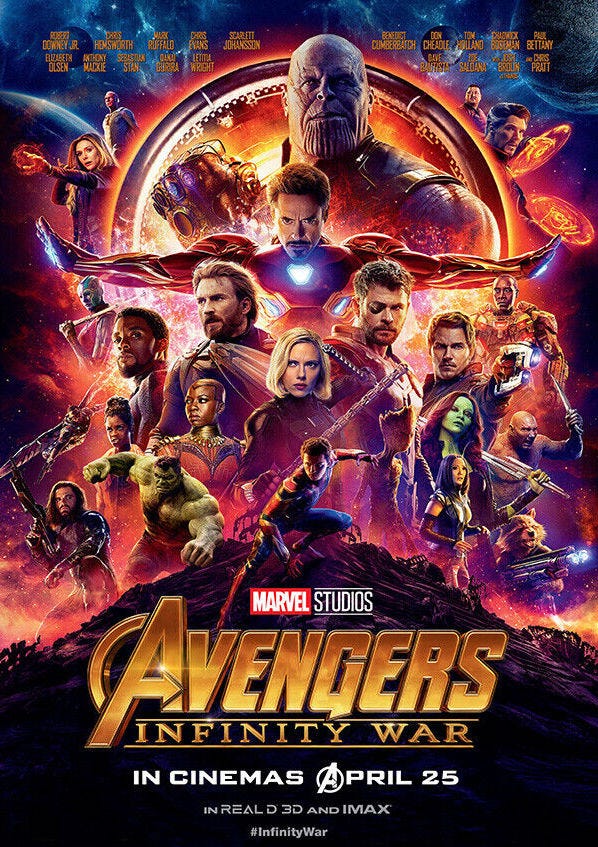
Examples of the use of orange/ blue colour contrasts with actor towers on franchise movie posters.
With delightful irony, someone has produced a Barbenheimer poster which also illustrates these common tropes perfectly.
So too, the very modern reliance on actors to use their social media platforms to relentlessly promote the work (for no money whatsoever just fyi, sometimes years after a project has completed filming) as opposed to it being the responsibility of the studio who created it. This has become an increasingly contentious issue in actor’s contracts, including my own, and is one of the number of grievances being hashed out as part of the actor’s strikes currently taking place in the US — as a direct result of the strikes, studios are being forced to once again promote their films themselves without their starring actors available. I generally love promoting work that I’m in but it is the contractual obligation that I personally object to, and also the nature of what is sometimes required particularly when it comes to social media.
Speaking of publicity, then there was Barbie. The most heavily promoted movie in recent times but I would also say willingly by all involved — who wouldn’t want to scream from the rooftops that they had something to do with this one?
Self-proclaimed by Greta Gerwig its creator (arguably the most coveted director to work with amongst actors) as “anarchic and wild and completely bananas.” Greta also wrote the film along with her filmmaker husband, Noah Baumbach.
Deep in the pandemic Greta Gerwig and Noah Baumbach were invited to get involved with Barbie by Margot Robbie who had obtained the rights from Mattel - Margot Robbie also produces as well as stars - and again according to Greta, in the spirit of “if we ever do get to go back to cinemas again, let’s do something totally unhinged”, they said yes. And truthfully? THANK GIRLS they did. Would you want to see a Barbie movie directed by anyone else? What hot footed me to this one, was undeniably its director.
I can’t not give a nod to the poster too. Though arguably less sophisticated than the Oppenheimer offering it still tells you everything you need to know about the movie without telling you too much. The knowingly simplistic artwork here is incredibly evocative. It makes you feel something deep in your bones whether you can identify it or not, whether you like it or not. The spirit of the movie is expressly clear. Its fluorescent pink heart is displayed firmly on its plasticised sleeve. The tag line is perfect. And actually, deceptively clever — if you’ve seen the film I know you know. For the particularly keen eyed, I think it’s worth noting that between the two posters I have shared, on which does the director’s name appear twice and on which does the director’s name not appear at all…
Thank you so much for being here. If you enjoyed this piece and would like to support my work, the best way is by taking out a paid subscription. Gift subscriptions are also available.
Of course we can’t mention these huge releases without dipping our toe in to the writers and actors strikes in America. Since May 2nd the Writer’s Guild in America (WGA) have been on strike, and the Screen Actor’s Guild (SAG) joined them in mid-July. With the exception of a small number of independent films that have been granted waivers, this has meant the shutting down of all production on any US funded film or television show that requires new writing or SAG actors - so pretty much everything that we would watch on streaming or in the cinema. The impact of this will mostly be felt in a few months time when content starts to dry up, unless you’re in the US where this is already affecting regular programming for all the live late night shows including Saturday Night Live.
Without getting into it too heavily, the main points of contention are pay rates and residuals which have been affected dramatically since streaming has become so established, and also the introduction of AI and its potentially catastrophic impact on the industry at large.
But AI and the streaming giants are not the only threats to the film industry. There is an insidious myth in Hollywood that original story-making is dead. That a franchise and its spin-offs are the only real way to guarantee high attendance (profits) in the cinema and thus this justifies their dominance over other kinds of story-making. It is suggested that a franchised big studio behemoth is the only thing that will save the faltering film industry which was already struggling prior to covid — because of the evolution of streaming.
The reason independent films are able to continue during the strikes is significant here. The smaller studios are not members of the corporate conglomerate known as the AMPTP (Alliance of Motion Picture and Television Producers) with whom the WGA and SAG are in confrontation with. The WGA and SAG sign an agreement with the AMPTP every three years to ensure fair working standards — the terms of this agreement is what the strike is over. BUt the small independent studios that have been granted waivers, have been allowed to continue filmmaking because they are already committed to the terms that the AMPTP have rejected. They are not trying to monopolise revenue nor exploit their employee base beyond reason. They are able to continue because they are not part of the problem, their priority is still simply to tell original stories. The big studios however would have us believe that that type of filmmaking is no longer worth the financial risk, so let’s pootle back in time a little bit…
Film studios used to make movies that would sustain their profits: tidily, healthily — to ensure they could keep making films at all different levels be they small-scale, large-scale, somewhere in between; knowing that here and there they would likely land a monster hit that would support all the rest. Some of them had IP behind them yes, the adaptations, but most of them were unique, original ideas, borne solely of someone’s creative imagination and whilst the studios were definitely making money, they were predominantly reinvesting it.
Even in the early days of streaming there was lots of big risk taking. With general subscriptions suddenly granting us access to hundreds of shows and movies with a huge variety of content, streamers could take risks without fear of losing subscribers. They were hailed as pioneers for it. Look at Amazon Studios. In the beginning, amongst it’s break-out shows were Transparent and even my own show, Fleabag. Amazon was tentatively making a move into the media sector and these shows although small and low-budget were risky investments, because of their original content and the stories they were telling. The risk of course paid off. The overwhelming success of both Transparent and Fleabag amongst others, contributed hugely to establishing Amazon as a leading provider of media. Then throw in the perfect storm of covid which exponentially accelerated the demand for streaming services from home and the streamers boomed. Other providers had their own break-out successes too and the once cool kids of innovation have since become as powerful if not more so than the major studios and structurally, their corporate equivalent but in doing so they have also forced all the other major studios to conform to the streaming model. Moreover, with great success (and gargantuan profits) have come heavy-weight shareholders, resulting in far more control and far less daring — and a disproportionate focus on profits. There is more fear and caution around original filmmaking now than ever before. I don’t know that Amazon would make these same shows today, or certainly in the same way without interference from producers. Late in 2019, barely a month after Fleabag’s big wins at the Emmys, Amazon consciously pivoted away from small-scale original productions in favour of projects such as Lord of the Rings.
Matt Damon explained brilliantly on an episode of Hot Ones recently, why this is happening, how this system is backfiring and how much story telling in film in particular has been directly affected since the advent of streaming.
“So what happened was the DVD was a huge part of our business, of our revenue stream. Technology has just made that obsolete, and so the movies that we used to make you could afford to not make all of your money when it played in the theatre because you knew you had the DVD [sales] coming behind the release.
In effect, the loss of DVD sales has therefore dramatically reduced the maximum amount of profit any given film can make, making box-office profits the be-all and end-all of a movie’s success. [DVD sales] would be like reopening the movie almost, and when that went away, that changed the type of movies that we could make.”
Matt Damon
So studios, effectively, in consolidating their businesses and conforming to the streaming model have not only limited the ways in which their content can be accessed but at the same time, completely reconditioned how we consume media and made it far less likely that we will even make the effort to go to the cinema to see the things that they have made. Driven by greed to monopolise the market, studios are now scrambling at the behest of their shareholders and to the catastrophic detriment of their workforce. As it turns out, subscriber fees also don’t equate to the enormous sums required to sustain the volume of content these platforms need to survive.
Matt Damon also talked about why all film making is risky so though you can try to mitigate risk it is ultimately in the DNA of filmmaking. Streaming, in trying to eliminate risk has disastrously exacerbated the problem.
What therefore excites me and my peers about the excitement around the Barbie and Oppenheimer releases, despite being made by members of the AMPTP (Warner Bros and Universal Pictures respectively) who have profited enormously (record profits in the case of Barbie in particular) is because I feel like people are ready to go back to the movies again and not in a post-covid way but in a post-franchise way. In a remembering what going to the cinema is all about way. A completely immersive and visceral experience with big hearted storytelling being the main draw. I absolutely love independent cinema but what actually feeds independent cinema, what facilitates it, is fantastic storytelling, at scale. Or at least it did when studios were reinvesting their funds. We have been starved of this in the age of Marvel and friends. But this really feels to me like movies are BACK. The first wave of it came with Top Gun: Maverick last Summer, a proper old-school action-movie with Tom Cruise doing the thing that only Tom Cruise can do and this Summer with these two big hitters, it really feels like there is some momentum behind this movement to get away from the superhero fixation, and move towards unusual, imaginative, original storytelling again.
Oppenheimer was weighty, explosive, historical, thought-provoking, an epic. I found its structure a little challenging as well as the balance of female representation — though both Florence Pugh and Emily Blunt were astonishing as always with the little they had to do (with Florence Pugh having to endure entirely unnecessary nudity for my money which felt truly icky). But I was grateful to have such a full, comprehensive picture of the human being behind this unbelievably destructive creation that I had known nothing about prior. And what is a life if not a collage of distorted memory? It felt good to be intellectually challenged byt he film’s format. It seemed to reflect Oppenheimer’s creative process and the way the memories he was plagued with in the wake of the bombs’ destruction, played out for him for the rest of his life. Perhaps Christopher Nolan also wanted to play with the idea of time not being linear by framing it in this way, we are dealing with Quantum Mechanics after all — which is not to suggest that the through-line wasn’t enormously considered. I wouldn’t want to do without the Lewis Strauss story strand either (though I found it most challenging to jump forward in time as well as backwards) because Robert Downey Jr was SO fantastic in the role. Honestly I could have watched him in in a separate movie for hours! I turly hope he gets an Oscar nod for that. I also couldn’t help but revel in the blissful kismet here of seeing him too flourishing outside of the Marvel Cinematic Universe.
Despite its flaws Oppenheimer felt important, timely. A siren call indeed, if anyone in a position of power would care enough to listen.
And then once again, there was Barbie. Abstract, sing it out, dance it off, nostalgia-overflowing, bubblegum colour explosion, hilarious, weird, surreal, exploring what it is to be a woman and what it is to be a man. It was equal parts bizarre and joyous. It felt epically balanced. It was subversive. It was deeply artful thanks entirely to the women behind it — again, would you want to see a Barbie movie directed by anyone else? I watched hours of interview coverage before it and it still totally surprised me in its tone. It wasn’t as pacy as I thought it would be, or fluid - maybe something to do with the editing? Maybe something intentional to mirror the staccato rhythm of a well-played with doll? But I had a blast and was deeply moved. The feminism felt a little on the nose in a way that I feel Greta Gerwig normally navigates effortlessly but it actually didn’t bother me. I saw someone comment (that hadn’t seen the movie) that it was just a two hour advert for Mattel but it genuinely didn’t feel to me like it was about the dolls or the actual merchandise at all, but our relationship to them and the enormous influence of constructed reality they have wielded on our culture. At no point did it feel as though I was being sold to in any way at least though the irony of the devastating impact of plastic on our environment as a result of this movie is not lost on me. Anything else? OH YES. Ryan Gosling was unbelievably fucking excellent like everyone has said and ultimately, I definitely want to see the film again. And you know me, then probs again and again.
I will also say this, here’s where Barbie and Oppenheimer are more similar than they are different. They are both interrogating existential dread. They are both examining the thrall of human creative endeavour. They both explore our relationship to the tactile world. They are both in pursuit of believing in doing something for the greater good that inevitably becomes a monster of its own making. They are both exploring events that changed the course of history (yes, even Barbie). In fact so much so, here’s a pop quiz to see if you can guess which of the two movies the below quote is from.
POP QUIZ — Is this a quote from Oppenheimer or Barbie?
“Humans only have one ending but ideas, they live forever.”
Throw your guesses in the comments — and no cheating if you already know it! In an ideal world you will actually have seen both movies and still can’t remember. I actually had to go back and remind myself of the correct answer since starting and finishing this piece!
Ultimately the franchised movie obsession has entirely stoppered this method of filmmaking. It has backed the industry into a corner and has it by its neck, shaking down its pockets. If your ‘opening weekend’ is not breaking records, it has failed in the eyes of the shareholders to whom studios have become completely enslaved, whose hand it is around their necks. People who might have rich bank accounts but the poorest of imaginations. This is impacting what stories are told, who gets cast in them, and who can afford to live off the back of them.
What both Barbie and Oppenheimer prove, is that there is clearly appetite for original storytelling and programming. Yes they both draw on IP (Barbie obviously Barbie and Oppenheimer the book, American Prometheus) but in a traditional sense of providing a catalyst for story as opposed to “we’ve acquired the rights to Marvel, let’s make 300 versions of basically the same film” (ok so, 32 movies thus far, 11 more at various stages of production, plus 12 television series, but still. And don’t get me started on Star Wars.)
Barbie and Oppenheimer demonstrate that original filmmaking is worth the financial risk and ps. you can make a LOT of films for a lot less than the cost of either of those movies and now because of those movies precisely as they used to do, where most of the money was reinvested back into the studio in order to do so, so I’m personally thrilled that cinema-goers have come out in their droves for them.
I believe that both the outcome of the strikes and this Summer of cinematic Love will contribute enormously to determining the future of my industry. It is certainly what me and my colleagues are fighting for. If not, the studio franchise and the streamers might as well call on the Bhagavad Gita as Oppenheimer once did:
Now I am become Death, the destroyer of worlds.
Tell me EVERYTHING. Were you inspired to go to see one or both of these movies? If yes, what inspired you to go? The hype? The poster? The actors? The director? Did you go to see them as a double bill and if so in what order? How did that impact your enjoyment? Are you keen to see more original programming at the cinema? I’d love to get a discussion going on this because it’s been such a hotly debated cultural moment.
Enjoy my writing and want to support it? Become a paid subscriber today. You’ll get full access to in-depth articles, inspirational tools, thoughtful community discussions, arts and meditation related gatherings, plus the full back catalogue of archived posts. You can also “like” my posts by tapping the heart icon, share them on Substack Notes or other social media, and/or send them to a friend.


